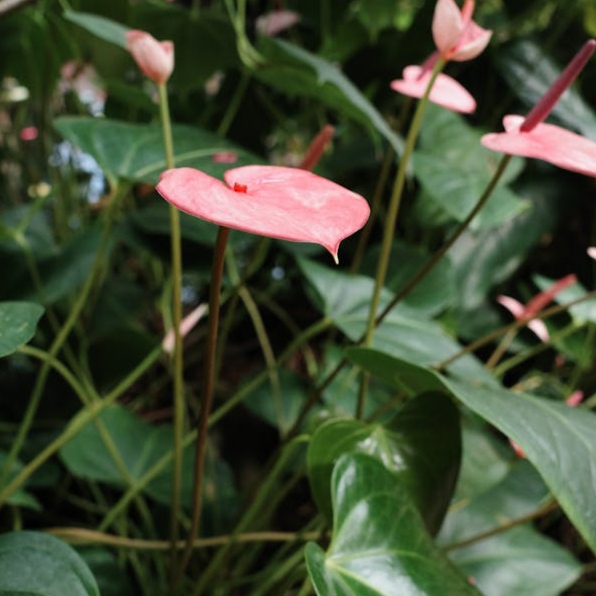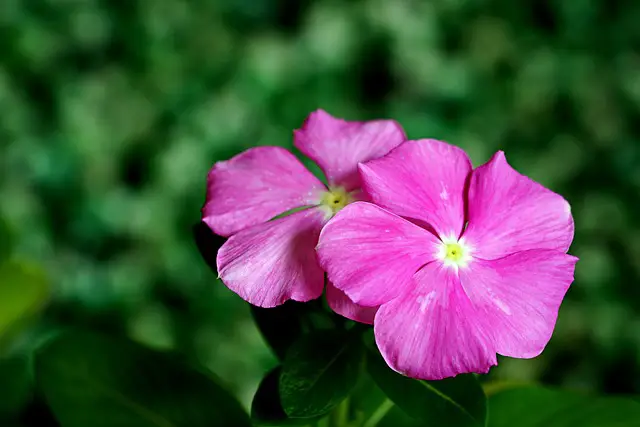The Pink Flamingo Plant (Anthurium andraeanum) is a stunning houseplant known for its glossy, heart-shaped leaves and striking pink spathes that resemble a flamingo’s vibrant feathers. With its exotic charm and air-purifying qualities, this tropical beauty is a favorite among plant lovers. But while it may seem effortless to grow, achieving lush, thriving foliage requires the right care techniques.
If you’ve ever struggled with drooping leaves, yellowing edges, or a lack of blooms, you’re not alone. Many plant owners unknowingly make small mistakes that impact their Anthurium’s health. The good news? With the right knowledge, you can transform your Pink Flamingo Plant into a show-stopping centerpiece in your home or garden.
In this guide, we’ll uncover the 10 best secrets for healthy, vibrant growth—from the perfect watering routine to the ideal humidity levels. Whether you’re a beginner or an experienced plant parent, these expert tips will help you master Pink Flamingo Plant care with confidence. Let’s dive in!

- 1 Pink Flamingo
- 2 Provide Bright, Indirect Light for Optimal Growth
- 3 Maintain the Right Watering Routine
- 4 Keep Humidity Levels High for a Tropical Feel
- 5 Choose the Perfect Well-Draining Soil Mix
- 6 Feed Your Flamingo Plant for Bigger Blooms
- 7 Prune and Clean Leaves for a Lush Appearance
- 8 Repot Every 1-2 Years to Prevent Root Bound Issues
- 9 Watch for Common Pests and Diseases
- 10 Ensure Warm Temperatures for Healthy Growth
- 11 Propagate Easily to Expand Your Collection
- 12 FAQs on Pink Flamingo Plant Care
Pink Flamingo
| Feature | Details |
|---|---|
| Scientific Name | Anthurium andraeanum |
| Common Name | Pink Flamingo Plant, Flamingo Flower |
| Plant Type | Tropical Perennial |
| Light Needs | Bright, indirect light |
| Watering | Keep soil slightly moist |
| Humidity | High (60-80%) |
| Temperature | 65-80°F (18-27°C) |
| Soil Type | Well-draining, airy mix |
| Toxicity | Toxic to pets and humans |
Provide Bright, Indirect Light for Optimal Growth
The Pink Flamingo Plant thrives in bright, indirect sunlight, making it perfect for well-lit indoor spaces. Direct sun can scorch its leaves, while too little light can slow its growth and reduce blooming. A spot near an east- or north-facing window with sheer curtains is ideal. Think about utilising a grow lamp to augment natural light if it’s not enough.Maintaining 12-14 hours of consistent lighting daily encourages healthy foliage and prolonged flowering.
Maintain the Right Watering Routine
Overwatering is a common mistake that can lead to root rot, a deadly condition for your Anthurium. Water your plant when the top 1-2 inches of soil feel dry, ensuring excess water drains completely. Use a pot with drainage holes to prevent stagnant water from accumulating. The Flamingo Plant prefers evenly moist soil but never soggy conditions. During winter, reduce watering since the plant’s growth slows down. Always use room-temperature water to avoid startling the roots.
Keep Humidity Levels High for a Tropical Feel
As a tropical plant, the Pink Flamingo Plant thrives in high humidity levels of 60-80%. Dry indoor air can cause leaf browning and curling. To increase humidity, use a humidifier, place the plant on a pebble tray filled with water, or group it with other houseplants. Misting can help, but be cautious—too much misting can encourage fungal growth. A bathroom or kitchen with good airflow can also provide the right humid conditions.
Choose the Perfect Well-Draining Soil Mix
A light, airy, and well-draining potting mix is essential for healthy root development. Use a mix containing peat moss, orchid bark, perlite, and coco coir to retain moisture while ensuring proper aeration. Avoid compacted, heavy soils, as they can suffocate roots and lead to rot. A high-quality Aroid mix is a great option since it mimics the plant’s natural rainforest habitat. Refresh the soil every 1-2 years to maintain nutrient levels and prevent compaction.
Feed Your Flamingo Plant for Bigger Blooms
The Pink Flamingo Plant requires regular feeding to produce its signature pink spathes. Use a balanced liquid fertilizer (20-20-20) diluted to half strength every 4-6 weeks during spring and summer. Phosphorus-rich fertilizers encourage better flowering, so switching to a bloom booster formula can help. Reduce feeding in the fall and winter when the plant enters a resting phase. Avoid over-fertilizing, as salt buildup in the soil can cause leaf burn and damage.
Prune and Clean Leaves for a Lush Appearance
Regular pruning keeps your Pink Flamingo Plant looking fresh and healthy. Remove yellowing, damaged, or dying leaves with sterilized scissors to encourage new growth. Cleaning the leaves with a damp cloth prevents dust buildup, allowing better photosynthesis and preventing pest infestations. If your plant has spent blooms, trim the flower stalk at the base to redirect energy toward new blooms and foliage growth. Additionally, pruning enhances the plant’s air circulation.
Repot Every 1-2 Years to Prevent Root Bound Issues
Repotting is essential to keep the Pink Flamingo Plant’s roots healthy and thriving. If you notice roots circling the bottom of the pot, it’s time to move it to a slightly larger container. Choose a pot 1-2 inches larger in diameter with proper drainage holes. Repotting every 1-2 years refreshes the soil, providing new nutrients for sustained growth. The best time to repot is in spring or early summer when the plant is actively growing.
Watch for Common Pests and Diseases
The Pink Flamingo Plant is relatively pest-resistant, but it can still attract mealybugs, aphids, spider mites, and scale insects.Keep an eye out for any indications of infestation on the leaves and stems. To naturally manage pests, use insecticidal soap or neem oil.Overwatering and poor airflow can also lead to fungal diseases like root rot or leaf spot. To prevent this, avoid wet leaves, improve ventilation, and ensure well-draining soil.
Ensure Warm Temperatures for Healthy Growth
Temperature fluctuations can stress your Pink Flamingo Plant, causing slow growth or wilting. Keep temperatures between 65-80°F (18-27°C), avoiding sudden drops below 55°F (13°C). Protect your plant from cold drafts, air conditioners, and heating vents, as extreme conditions can damage the foliage. If you live in a colder climate, move your plant away from windows and doors during winter to prevent temperature shocks.
Propagate Easily to Expand Your Collection
Propagation is an exciting way to grow more Pink Flamingo Plants without buying new ones. The best method is division, where you carefully separate mature plants with multiple stems. Use a sharp, sterile knife to divide the plant, ensuring each section has healthy roots. Repot the new divisions in fresh soil and keep them in a humid, warm environment until they establish. This method not only multiplies your plants but also helps revitalize older plants.
The Pink Flamingo Plant is a stunning, low-maintenance houseplant that rewards you with year-round tropical beauty when properly cared for. By providing bright indirect light, proper watering, high humidity, and regular feeding, you can enjoy vibrant pink flowers and healthy foliage. Remember to prune, repot, and watch for pests to keep your plant thriving. Whether you’re a beginner or an experienced plant parent, these 10 best secrets will ensure your Anthurium flourishes for years!
FAQs on Pink Flamingo Plant Care
What is the best soil for Pink Flamingo Plant Care?
The Pink Flamingo Plant Care requires well-draining soil with a mix of peat, perlite, and compost. This ensures proper aeration and moisture retention, preventing root rot. A slightly acidic to neutral pH is ideal for Pink Flamingo Plant Care, promoting healthy root growth and vibrant foliage.
How often should I water for Pink Flamingo Plant Care?
Water the plant once a week or when the top inch of soil feels dry. Pink Flamingo Plant Care requires consistent moisture but avoids overwatering, which can lead to root rot. Reduce watering during winter as Pink Flamingo Plant Care enters dormancy and requires less hydration to thrive.
Does Pink Flamingo Plant Care need humidity?
Yes, Pink Flamingo Plant Care thrives in high humidity levels of 60–80%. If the air is too dry, use a humidity tray, mist the leaves occasionally, or place a humidifier nearby. Maintaining humidity ensures the plant’s leaves stay healthy and prevents browning or drying out.
What light is ideal for Pink Flamingo Plant Care?
The Pink Flamingo Plant Care grows best in bright, indirect sunlight. Too much direct sunlight can scorch its leaves, while low light may cause leggy growth. Place it near an east or north-facing window for the best results. Grow lights can also supplement lighting in darker areas
Can Pink Flamingo Plant Care tolerate cold temperatures?
No, Pink Flamingo Plant Care prefers temperatures between 65–80°F (18–27°C). Cold drafts and sudden temperature drops can cause stress and damage the plant. Keep it away from air conditioners, open windows in winter, and heating vents to ensure it remains in a stable, warm environment.
How to prune for Pink Flamingo Plant Care?
Pruning helps maintain Pink Flamingo Plant Care’s shape and health. Trim yellow or dead leaves with sterilized scissors to encourage new growth. Remove any leggy stems to promote bushier growth. Regular pruning prevents disease, enhances airflow, and keeps the plant looking lush and vibrant throughout the year.
How do I repot for Pink Flamingo Plant Care?
Repot Pink Flamingo Plant Care every 1–2 years or when roots outgrow the pot. Choose a slightly larger container with drainage holes and refresh the soil. Spring is the best time for repotting, as Pink Flamingo Plant Care enters active growth and can recover quickly from transplant shock.
What pests affect Pink Flamingo Plant Care?
Common pests include spider mites, aphids, and mealybugs. Check the undersides of leaves regularly. To prevent infestations, wipe leaves with a damp cloth and use insecticidal soap or neem oil. Proper Pink Flamingo Plant Care includes maintaining humidity and airflow to reduce the risk of pest problems
How do I propagate Pink Flamingo Plant Care?
Propagate Pink Flamingo Plant Care using stem cuttings or division. Take a healthy stem cutting, let it dry for a day, and plant it in moist soil. For division, separate offsets from the main plant and replant them. Keep humidity high to encourage root development for successful propagation.
What type of pot is best for Pink Flamingo Plant Care?
A well-draining pot with drainage holes is essential for Pink Flamingo Plant Care. Terracotta or ceramic pots help wick away excess moisture, preventing root rot. Avoid plastic pots without drainage, as they can trap water. Choose a pot that’s slightly larger than the root ball to support growth.
Does Pink Flamingo Plant Care need regular misting?
Yes, misting helps maintain humidity for Pink Flamingo Plant Care, especially in dry environments. However, avoid excessive misting, as it can promote fungal issues. A humidity tray or a room humidifier is a better option. Ensure proper air circulation to prevent moisture-related diseases like leaf spots or rot.
Can Pink Flamingo Plant Care grow outdoors?
Yes, Pink Flamingo Plant Care can grow outdoors in warm, tropical climates. It thrives in partial shade with indirect sunlight. If temperatures drop below 60°F (15°C), bring it indoors. Protect it from strong winds and heavy rain, as excess moisture can lead to root rot and fungal infections.
How long does it take for Pink Flamingo Plant Care to grow?
With proper care, Pink Flamingo Plant Care grows steadily and can reach maturity within a year or two. Growth speed depends on light, humidity, and watering. Regular fertilizing and repotting every 1–2 years help maintain healthy growth. Proper Pink Flamingo Plant Care ensures lush foliage and long-lasting beauty.








